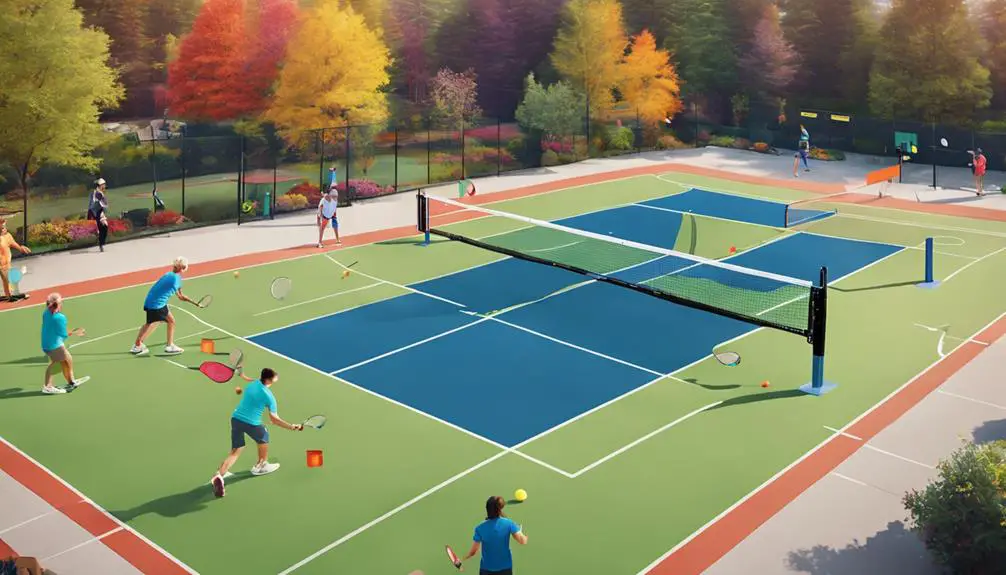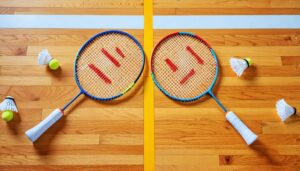When comparing pickleball and badminton, you’ll find they offer unique experiences. Pickleball, with its smaller court and lower net, promotes a casual atmosphere, making it accessible for beginners. On the other hand, badminton demands quick reflexes and agility, appealing to competitive players. While pickleball is growing rapidly, especially in North America, badminton has a rich history and international presence. The equipment varies, too; pickleball uses solid paddles, whereas badminton relies on lightweight rackets. Both sports provide great health benefits, but the choice often boils down to your personal taste and goals. There’s more to explore on how they stack up against each other.
Overview of the Sports
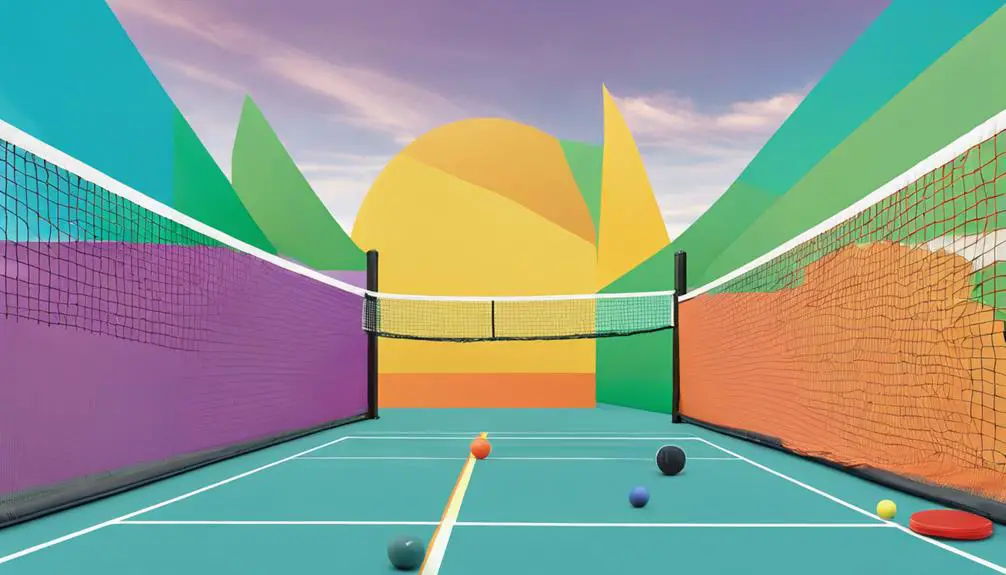
When you immerse yourself in the world of racquet sports, two names often come up: pickleball and badminton. Each sport carries its own unique history and charm, appealing to a diverse range of players. Regarding history comparison, badminton traces its roots back to the mid-19th century in England, evolving from a game called “poona,” which originated in India. On the other hand, pickleball is relatively new, having been invented in 1965 in the United States as a backyard pastime that quickly gained traction.
As you explore popularity trends, you’ll notice that badminton enjoys a strong international presence, particularly in Asia and Europe, where it’s a staple in competitive sports. The sport consistently draws large audiences during events like the Olympics and World Championships. Conversely, pickleball has exploded in popularity across North America over the last decade, largely due to its accessibility and the social nature of the game. It’s often played in community centers and parks, making it an appealing choice for players of all ages.
While both sports promote physical activity and social interaction, their paths have diverged. Badminton boasts a rich competitive history, while pickleball thrives on community engagement and casual play. Ultimately, your choice between the two could depend on your personal preferences, whether you’re drawn to the finesse of badminton or the laid-back vibe of pickleball. Each sport offers a unique experience that reflects not just gameplay, but also a way to connect with others.
Equipment Comparison
In comparing the equipment used in pickleball and badminton, you’ll find distinct differences that cater to the unique demands of each sport. Understanding these differences can enhance your experience, whether you’re just starting or looking to refine your skills. Here’s a breakdown of key equipment elements:
- Racket Types: In badminton, you’ll use a lightweight racket designed for quick swings, while pickleball features a solid paddle that resembles a large, flat racket. This impacts how you interact with the ball or shuttlecock during play.
- Paddle Materials: Pickleball paddles are typically made from composite materials or wood, providing a durable surface for striking the ball. Badminton rackets, on the other hand, are often crafted from aluminum or carbon fiber, ensuring speed and maneuverability.
- Ball Differences: The ball in pickleball is a plastic sphere with holes, designed for a controlled bounce on a court. In contrast, badminton uses a feathered or synthetic shuttlecock, which glides through the air and is affected by wind.
- Shuttlecock Design and Net Height: The shuttlecock’s design impacts gameplay, as its shape and material influence how it travels. Additionally, net height varies: badminton nets are set at 5 feet, while pickleball nets are lower, at 34 inches in the center, allowing for different styles of play.
These equipment distinctions not only define each sport but also shape your strategy and enjoyment on the court.
Rules and Gameplay
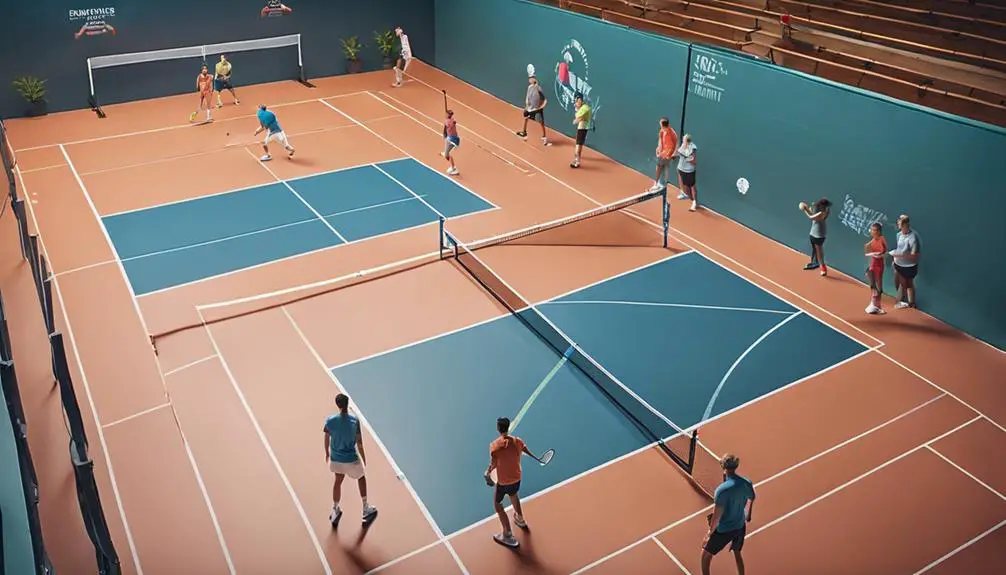
While both pickleball and badminton share the essence of racquet sports, their rules and gameplay create distinct experiences that cater to different skill sets and strategies. Understanding these differences can enhance your enjoyment and performance in either sport.
In pickleball, the scoring system is straightforward. You can only score points when you’re serving, and matches are typically played to 11, 15, or 21 points, with a requirement to win by at least two points. The game flows with a mix of serve-and-volley and strategic positioning, making it engaging for players of all levels.
On the other hand, badminton employs a rally scoring system, allowing players to earn points regardless of who served. Matches are usually played to 21 points, but the winner must also have a two-point lead, which can lead to nail-biting finishes. The pace is fast, with quick reflexes and agility being essential for success.
Here’s a quick comparison of key aspects:
| Aspect | Pickleball | Badminton |
|---|---|---|
| Scoring System | Points only on serve | Rally scoring, points on any serve |
| Match Durations | 11, 15, or 21 points | Always played to 21 points |
| Court Size | Smaller court | Larger court |
| Net Height | 36 inches at the ends | 5 feet 1 inch |
| Service Rules | Underhand serve only | Overhand or underhand serves allowed |
Court and Playing Area
How does the court and playing area influence the dynamics of pickleball and badminton? The distinct court dimensions and playing surface of each sport create unique experiences that affect strategy, movement, and overall gameplay.
- Court Dimensions: Pickleball courts are 20 feet wide and 44 feet long for doubles, while badminton courts are slightly wider at 20 feet and longer at 44 feet for singles and 20 feet by 20 feet for doubles. This difference impacts how players navigate the space, with pickleball often encouraging more strategic positioning and shot placement.
- Playing Surface: The playing surface also varies considerably. Pickleball is typically played on a hard surface, allowing for a faster game with quick volleys. In contrast, badminton courts usually have a wooden surface, offering a different grip and feel, which can affect your footwork and agility.
- Net Height: The net height further distinguishes the two sports. Pickleball nets stand at 36 inches, while badminton nets are set at 5 feet in the center, altering how players approach their shots and defenses.
- Court Lines: The lines on each court also define how plays are constructed. Pickleball’s non-volley zone (the kitchen) encourages strategic play near the net, while badminton’s service areas dictate serve techniques and positioning.
Understanding these elements not only enhances your appreciation of each sport but also helps you adapt your gameplay to thrive in both environments.
Skill Levels and Accessibility
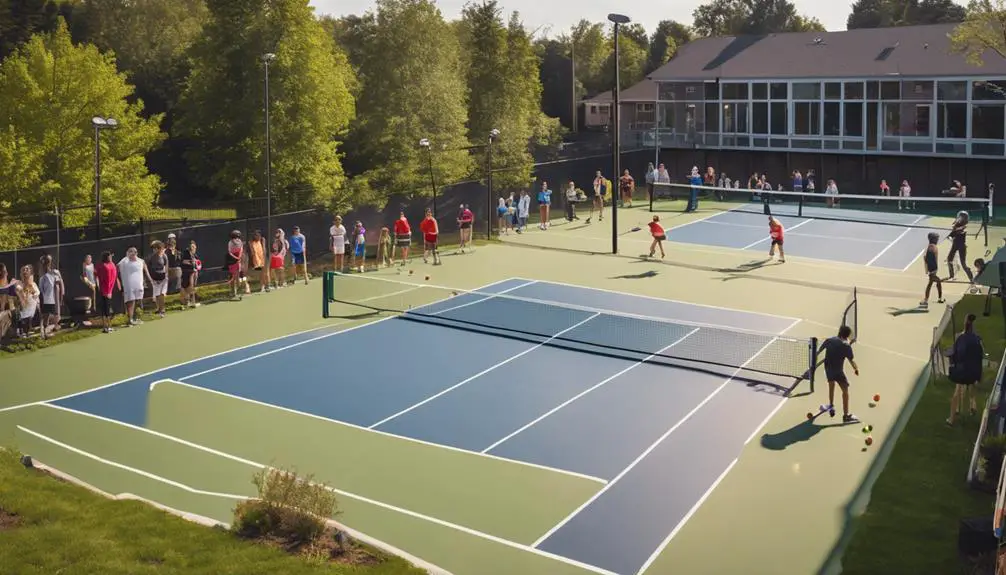
Understanding the dynamics of court and playing area sets the stage for exploring the varying skill levels and accessibility of pickleball and badminton. While both sports offer enjoyable experiences, they cater to different audiences based on skill levels and the ability to engage with the game.
Pickleball is often praised for its accessibility, particularly for beginners. The smaller court size and slower-paced gameplay reduce beginner challenges, allowing newcomers to grasp the fundamentals more easily. You don’t need advanced athleticism to enjoy a casual game, which encourages players to engage without the weight of a competitive mindset. This makes pickleball an ideal choice for families and social gatherings, fostering a relaxed atmosphere where everyone can participate.
On the flip side, badminton tends to present steeper learning curves. The need for quick reflexes and agility can pose beginner challenges that might deter less experienced players. However, for those with a competitive mindset, badminton’s fast-paced nature can be thrilling and rewarding. Players often find themselves aiming for improvement, as the sport demands a blend of strategy, skill, and physical prowess.
Ultimately, both sports offer unique pathways to enjoyment and competition. Whether you’re drawn to pickleball’s inclusive vibe or badminton’s intensity, understanding these distinctions can help you choose the right sport for your skill level and aspirations. Embrace the freedom to explore both, and find what resonates with your personal journey in the world of racquet sports.
Health Benefits and Fitness
Regularly engaging in either pickleball or badminton offers a multitude of health benefits that can enhance your overall fitness. Both sports provide a unique blend of cardiovascular benefits and muscle engagement, making them excellent choices for staying active. Whether you’re smashing a shuttlecock or dinking a pickleball, you’ll discover notable advantages to your health.
Here are four key benefits you can expect:
- Cardiovascular Fitness: Both sports elevate your heart rate, improving circulation and endurance. You’ll find that regular play enhances your cardiovascular health considerably.
- Calorie Burn: Depending on the intensity of your game, you can burn a considerable amount of calories. This makes both sports effective options for weight management and fitness enhancement.
- Agility and Coordination: The fast-paced nature of these games sharpens your agility and coordination skills. You’ll notice improvements in your reflexes and overall movement efficiency over time.
- Social Interaction and Stress Relief: Engaging in either sport often involves playing with friends or joining local clubs, which fosters social interaction. This camaraderie can reduce stress and provide a sense of community, enhancing your mental well-being.
Moreover, both sports typically have a lower joint impact compared to other high-impact activities, making them suitable for a wider range of ages and fitness levels. So, whether you’re looking for a fun way to stay fit or seeking stress relief, pickleball and badminton offer you the freedom to enjoy fitness while reaping considerable health benefits.
Frequently Asked Questions
What Are the Origins of Pickleball and Badminton?
You might be surprised to learn that both sports emerged in different eras. While badminton’s roots trace back to 19th century England, pickleball evolved in the 1960s, featuring unique court dimensions and game equipment that inspire diverse play.
Can You Play Pickleball and Badminton Indoors or Outdoors?
You can definitely play both sports indoors and outdoors. Indoor surfaces provide consistent play, while outdoor conditions can vary, affecting your game. Embrace the freedom to choose your setting for each thrilling match!
How Do Pickleball and Badminton Affect Social Interaction?
Both sports foster team dynamics and community engagement, allowing you to connect with others. You’ll find yourself building friendships, enhancing communication skills, and enjoying a sense of belonging that comes from shared experiences in play.
Are There Professional Leagues for Pickleball and Badminton?
Yes, there are professional leagues for both sports, each with established player rankings. You’ll find intense competition and growing popularity, making them exciting arenas for athletes and fans who crave the thrill of high-level play.
What Age Groups Most Commonly Play Pickleball and Badminton?
You’ll find a vibrant spectrum of age groups enjoying these racquet sports, with demographic trends showing younger players driven by social interaction, while older participants seek fitness and fun, motivated by a longing for community and freedom.

